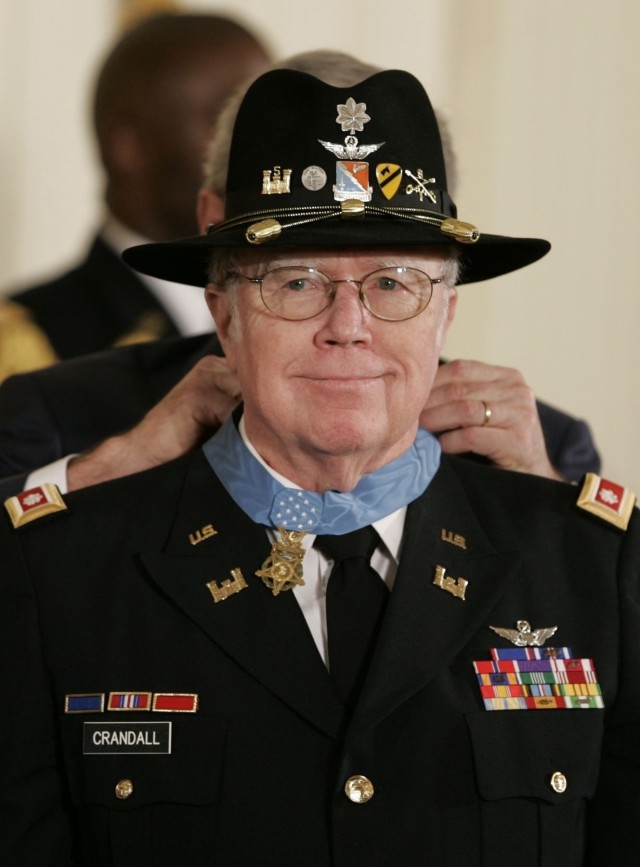WASHINGTON (Army News Service, Feb. 26, 2007) - President Bush today presented the Congressional Medal of Honor to retired Lt. Col. Bruce P. Crandall for his actions at the Battle of Landing Zone X-Ray in Vietnam's Ia Drang Valley.
The November 1965 battle was the first major battle of the Vietnam War.
"The medal is the highest military decoration a president (can bestow)," Bush said during a speech to guests who attended the White House ceremony, among them Secretary of Defense Bob Gates, Secretary of the Army Francis J. Harvey and Chairman of the Joint Chiefs of Staff Marine Gen. Peter Pace.
Bush, starting off his remarks on a light note, referred to Crandall as "a bit of a handful growing up; one of his teachers said he had a unique ability to get in and out of trouble without any trouble at all."
On a more serious note, Bush recounted the events that have earned Crandall the highest praises of his comrades in Vietnam and ultimately brought him to the White House.
"They flew through a cloud of smoke and a wave of bullets," Bush said of Crandall and his wingman, then-Capt. Ed Freeman. "(They) carried out the wounded, although that wasn't (their) mission. If he had stopped (after one rescue attempt), he would have been a hero. But he went back 14 times - until every man was evacuated."
Although Crandall made no remarks at today's ceremony, Bush quoted him as saying earlier, "There was never a consideration that we wouldn't go into those landing zones (to rescue the wounded)."
Tomorrow, Secretary of the Army Harvey will induct Crandall into the Hall of Heroes during a ceremony at the Pentagon.
At today's ceremony, Crandall was recognized for repeatedly flying into a landing zone under intense enemy fire to rescue and re-supply a battalion of 1st Cavalry Regiment ground troops, even after the LZ had been closed.
"Due to policy at the time, medevac pilots weren't allowed to land on a landing zone until it was 'green' for a period of five minutes, meaning it wasn't being relentlessly attacked," said Crandall, then a major. Freeman, Crandall's friend of 10 years at the time, also participated in the risky life-saving missions.
Witnesses said the actions taken by Crandall and Freeman on the first day of the battle, Nov. 14, kept the 1st Battalion, 7th Cav. Regt., re-supplied and reinforced, and saved the lives of wounded Soldiers who would surely have died had they not been evacuated.
The two aviators flew 14 missions, encountering intense enemy fire as they delivered much-needed ammunition to the ground troops and flew more than 70 casualties to safety. Freeman was awarded the Medal of Honor in July 2001 for his actions in the November battle.
Retired Col. Ramon Nadal was an eyewitness and former company commander in the 1st Bn., 7th Cav. Regt. Of the pilots' bravery, he said: "Without their support, both by re-supplying us with ammo and bringing reinforcements, we might well have been overrun."
Bruce did not only do good things for Company A at Camp X-Ray, Nadal said. "Months later, in Bong San, he volunteered to evacuate some of my Soldiers from a nighttime battle in the middle of a Vietnamese village, when no one else would fly into the tiny landing zone under enemy fire."
A grateful ground commander, retired Lt. Gen. Harold Moore, who was a lieutenant colonel leading the Ia Drang battle, said that without Crandall's "extraordinarily heroic effort" that day, "we on that field would have gone down."
In 1966 Crandall received the Aviation and Space Writers Helicopter Heroism Award for rescuing a dozen Soldiers from another battlefield under fire. In 1996 he was inducted into the Air Force's Gathering of Eagles, an association of aviation pioneers and distinguished flyers. In 2004 he was inducted into the Army Aviation Hall of Fame.
Crandall will be inducted Tuesday into the Hall of Heroes at the Pentagon. His name will be engraved in the wall beside the names of some 3,000 other servicemembers who have been awarded the nation's highest honor.
At the induction ceremony for one of the heroes last month, Deputy Defense Secretary Gordon England said, "There are rare heroes who affirmatively make the decision to do an extraordinary thing and give up their lives for others. That's the reason we gather here today, to stand in awe of that choice ... and pay tribute."
Crandall retired as a lieutenant colonel in 1977, and in civilian life served as city manager for Dunsmuir, Calif., and in other public works positions in Arizona.
For more information on the Medal of Honor and Crandall, see <a href="http://www.army.mil/medalofhonor/crandall"target=_blank> www.army.mil/medalofhonor/crandall</a>.
(Heike Hasenauer is the senior editor of "Soldiers" magazine.)








Social Sharing